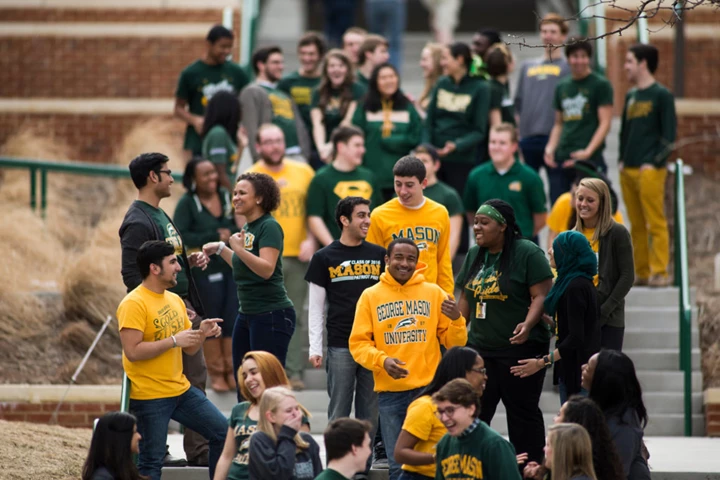Symbiotic partnership: Supporting university mission through comprehensive internationalization

In the days following the second annual P3·EDU Conference, hosted by George Mason University (GMU) in May, former GMU President Angel Cabrera posited that “the private sector holds the key to solving many of the challenges public and non-profit universities face.” The success of such partnerships, Cabrera highlighted, depends on the capacity of private sector parties to support their higher education partners’ strategic goals, protect their academic reputations, and prioritize student experience.
From our first with the University of East Anglia in the United Kingdom to our most recent with Hofstra University in New York, every INTO university partnership is predicated on student success and campus enrichment. At GMU, Colorado State University (CSU), and Drew University, INTO-affiliated faculty are leading initiatives to not only better serve international student populations but support their institutions’ overarching missions. In so doing, they exemplify the symbiosis INTO shares with its partner universities.
In addition to partnership with INTO, GMU’s participation in the American Council on Education’s Internationalization Lab has energized comprehensive internationalization efforts on campus. As part of the 18-month program, senior administrators and faculty in the INTO Mason center for international students have formed an institution-wide internationalization task force to assess and enhance current internationalization practices. Dr. Karyn Kessler, academic director at INTO Mason and assistant professor, TESOL/applied linguistics, is co-chair of the task force.
Kessler understands the importance of connecting the internationalization efforts she leads to Mason’s wider strategic initiatives.
“We are not competing with the University’s strategic goals,” Kessler said. “Rather, we’re linking them in to demonstrate that internationalization helps forward these goals.”
Kessler’s team has centered internationalization efforts on the topics of diversity, inclusion, and well-being, three themes for institutional advancement that, per President Cabrera, represent “the center of what George Mason University is.”
Kessler emphasizes that the University’s internationalization efforts hinge upon the input of both the administrators responsible for implementing campus-wide transformations and the experts on international student learning and experience with whom she works in the INTO Mason center and across the University.
“It is a true collaboration between the University and INTO Mason faculty,” she said.
Similarly, at CSU, INTO CSU faculty have helped developed the University’s Global Village, a living and learning community that brings together domestic and international students to promote social integration, encourage cross-cultural understanding, and develop leadership skills. Dr. Fabiola Ehlers-Zavala, executive director at INTO CSU, explained that the “initiative was framed within the larger effort of the University to promote retention and graduation among all students.” With the Global Village, University and INTO CSU faculty support student retention through the provision of innovative curricular and co-curricular offerings that support new students during their transition to life at CSU.
More than a testament to the ways comprehensive internationalization efforts can bolster a university’s wider strategic initiatives, the Global Village involves the close collaboration of student affairs staff and academic faculty both within and beyond the INTO CSU center to promote positive student outcomes. As someone who specializes in pedagogical training, Dr. Ehlers-Zavala is happy to see the benefits enjoyed by both student affairs professionals and academic leaders as they share strategies to meet all students’ needs.
“The success of our students is the result of student affairs professionals and academics working together,” she said. “Global Village shows that such collaboration works.”
In the case of Drew University, one of INTO’s smaller, private partner institutions, the presence of INTO Drew has pushed the University to think about general education differently. Dialogue between INTO Drew faculty and senior administrators informed the University’s new, comprehensive approach to undergraduate education, called Launch. The initiative demands that students think about career development from the start of their undergraduate study, emphasizing the need to prepare for the global context in which graduates will seek employment.
As Launch was developed, INTO Drew faculty and staff were polled on the opportunities presented by the University’s growing international student cohort. Their feedback ensured that the resulting curriculum would create an inclusive, multicultural community that empowers all students to prepare for their careers after college.
“INTO Drew has changed the context of what it means to be a student at this University,” Dr. Sharon Sundue, executive director at INTO Drew and vice president of academic affairs for INTO North America, said. “Faculty are able to engage in global issues in a way they simply could not before.”
At INTO, we know that comprehensive internationalization must not compete with an institution’s mission. Instead, it must exist in symbiosis with teaching, research, and service. Progress depends upon the knowledge and passion of university administrators and faculty who work hard to push their institutions to new heights. INTO simply seeks to complement that know-how and enthusiasm with our own resources—those of an organization that is proud to have supported the global ambitions of 24 universities around the world—in order to advance campus-wide internationalization and strategic growth.